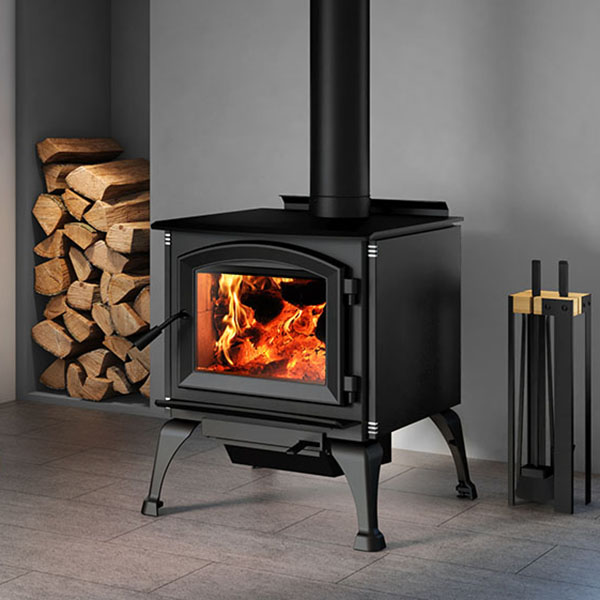The Types of Wood Stoves
So you’re building a new home or remodeling your older one, and you’ve toyed with the idea of adding a wood-burning fireplace. You like the old-world charm a free-standing stove and that it can heat your whole space, but have no idea of what you’re looking for. You’re frustrated at the lack of good information online and feel that visiting a local store is a little much since you’re just in the planning stages. This article is written specifically for you – to help you understand the main types of free-standing wood stoves available.
 First, a quick tidbit on wood-stoves. Anything high-efficiency and wood-burning can be considered a wood stove. They can be built into new walls (we call them fireplaces), inserted into existing older fireplaces (we call those inserts), or free-standing in a room (we call them stoves). All three work the same but the difference is the application. Free-standing stoves are the most recognizable since they stand freely in the room so they can radiate the heat best.
First, a quick tidbit on wood-stoves. Anything high-efficiency and wood-burning can be considered a wood stove. They can be built into new walls (we call them fireplaces), inserted into existing older fireplaces (we call those inserts), or free-standing in a room (we call them stoves). All three work the same but the difference is the application. Free-standing stoves are the most recognizable since they stand freely in the room so they can radiate the heat best.
There are three main types of new wood stoves
There are many other types of older stoves, but for ease of explaining and since most people will want something new with a proper warranty, safety clearances, etc., we will just talk about modern stoves.
Steel Wood Stoves
The first type of wood stoves are steel stoves. These stoves are built using high-grade steel, welded or bolted together to create a heavy-duty burning machine. These stoves are almost always black and a little more basic looking than some other fancier stoves. They will heat up the quickest of the bunch and cool down the quickest, which means the heat can fluctuate if you’re not steady with your wood-loading. These stoves, because of the cut-steel fabrication and ease of assembly, are typically also lower priced and will be your best bet for ‘entry-level’. This does not mean that steel stoves are junk – in fact I consider these the best “bang-for-the-buck” stoves, since most high-grade steel stoves still weigh over 400 pounds and are NOT cheap junk. But, you do need to be careful since lower-priced brands will use thinner materials and will not be as heavy-duty. Popular steel stove brands include Enerzone, Osburn, Pacific Energy, Napoleon, and more.
Ideal for: Someone who wants a nice basic stove and isn’t picky about the looks
Cast-iron Wood Stoves
Cast-iron stoves are the next, and probably most common type of stove out there. These stoves will take longer to heat up and will hold onto the heat longer than steel stoves will. Built using cast-iron pieces, typically around a cast or steel firebox, these stoves are built to last and you’ll know that if you help carry one up a flight of stairs. In addition to the heat life, the biggest and most obvious difference is the looks. Using cast-iron pieces, manufacturers are able to create beautiful designs, ornate styles, and a rustic look. A lot of times cast-iron stoves are also available in enameled colors, again furthering the decorative flair. Famous brands of cast-iron stoves include Jotul, Lopi, Hearthstone, Vermont Castings, and more.
Best for: Someone wanting a great, 20+ year stove and wants it to look great, too.
Soapstone Wood Stoves
At the top of the wood-stove hierarchy are soapstone stoves. These stoves are built using thick soapstone slabs, bolted together with cast-iron trim. The soapstone is incredibly dense and retains heat for much longer than steel or even cast-iron will. In addition to the stretched-out heat life, the stoves are essentially also a piece of fine furniture. While the look may not be to everyone’s taste, there is a certain charm of a woodstove clad in a natural, grey-blue stone. Soapstone stoves use the same type of burn technology as the other stoves listed above, so while you won’t get any revolutionary efficiency boost, you can count on the stove staying hot for days depending on how you burn. The most popular brand, and pioneers of the soapstone style, is Hearthstone.
Best for: Someone who wants a piece of furniture that will stay hot for days at a time
 Quality & Reputation
Quality & Reputation
All woodstoves are subject to EPA certification which means they all must be extremely efficient and clean-burning. Some stoves will be a few percentage points better than some others, but for the most part every new stove out there will be pretty darn efficient. The fireboxes of the above stoves will stay relatively constant regardless if it’s built around a steel, cast, or soapstone outer frame, which in theory means they will all burn similar. But just like anything else, certain brands or models will be built or designed better to create a superior product. Quality and reputation are extremely important and should be taken seriously, since it’s too costly and impractical to replace your woodstove every 10 years.
Lasting Takeaway: Buy quality, regardless if you want budget-friendly steel, heritage cast-iron, or rustic soapstone stove.
